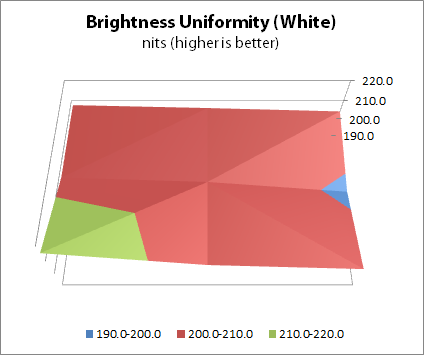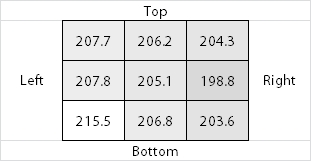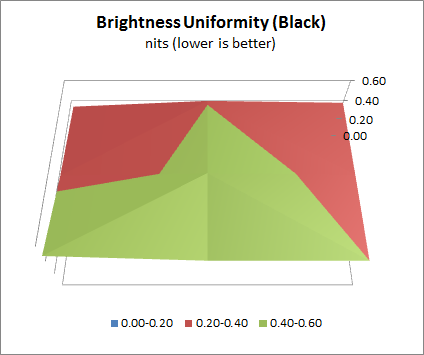NEC PA301w: The Baddest 30-inch Display Around
by Brian Klug on March 1, 2011 8:00 AM ESTBrightness Uniformity
For brightness uniformity, we test at the same 9 points we measure Delta-E on, but this time measure white and black levels when the center point is as close to 200 nits as we can get. We use the same colorimeter and software as before, - an Xrite i1D2 and ColorEyes Display Pro. Similar to the ordinary brightness test (taken at the center), contrast is set to 100 in the OSD and brightness is set to as close to 200 as possible in the center before measurements are taken.
White Uniformity


Black Uniformity


It appears that the PA301w's built-in uniformity settings help keep the brightness profile very steady in the full on white test. There's a tiny horizontal dependence from left to right, but it's imperceptible in practice, and the standard deviation of these readings is just 4 nits. Uniformity in the white department is actually very good.
Blacks are a little worse, again the bottom left seems to be brighter than the rest of the display by a measurable and consistent amount. On the whole again though the consistency is pretty good. Displaying a purely black image, there's also no obvious light leakage anywhere on the display.










92 Comments
View All Comments
63jax - Tuesday, March 1, 2011 - link
I'm also very curious about Samsung's PLS matrix. i also want to change my monitor with an IPS or PVA panel in 22'' range, but i'm really undecided. Maybe i will wait to see what PLS are capable of. Good review by the way, thanks.softdrinkviking - Tuesday, March 1, 2011 - link
At 22", you can get a lot of great quality LCDs for reasonable prices. If you can spend 300-400, I would go for IPS, if you want to stick closer to 200, you can get a VA screen from BenQ that is 23" widescreen and looks pretty good to me. The VA screens have between the viewing angles of the IPS and the TN, but without the color shift I noticed on TNs. When a VA goes out of view, it just looks dark, not pink or something weird like a TN.But I don't know how "calibration-friendly" VAs are. If photography is a concern for you, and you need the print to match the image in your screen, I think IPS is better.
This new samsung technology is anybodys guess, but I wouldn't get one until they have been put through the paces a bit and prove reliability.
NEC and LG have had a long time to work the kinks out of IPS, and it's widespread adoption in critical industries did not occur by chance.
eaw999 - Wednesday, March 2, 2011 - link
va's calibrate fine. many eizo's use va panels. but va panels have off-angle gamma shift, though, and it doesn't take a lot of angle to notice it. for me, anyway. this is most evident in darker shades. i tried an eizo monitor once and i couldn't stand watching movies on it because if i moved my head even slightly, shadow details would 'shimmer'. the only thing i liked about the eizo was that it had phenomenal black levels, as modern va panel usually do.legoman666 - Tuesday, March 1, 2011 - link
It's amusing to see that Anandtech staff run adblock+ on their own website.quiksilvr - Tuesday, March 1, 2011 - link
ROFL! Even they admit their adverts are annoying as hell.Stas - Wednesday, March 2, 2011 - link
lol. Sponsors won't be happy about that ^.^gc_ - Thursday, March 3, 2011 - link
I expect the advertisers paid for ads alongside articles, not for in-article placement. I expect advertisers also paid to have ads displayed during a certain period (say, a week or a month), not necessarily to have it display in-perpetuity in the archives. I don't know if AnandTech is syndicated and/or translated for different markets, but if it is, then if they included the ads they might have to redo the image for every market.DanNeely - Tuesday, March 1, 2011 - link
"Interestingly enough, the PA301w has a uniformity setting inside the OSD which defaults to 5 (maximum) and seems to definitely improve overall brightness uniformity and Delta-E consistency. Whatever secret sauce NEC has apparently works. "If this works the same way I think it does on the 3090, the internal LUT adjusts different parts of the screen differently to boost uniformity. I'd be curious what happens to it in 10bit mode though, since the 3090 did this by mapping 8 bit input to a 10bit panel/LUT.
DanNeely - Tuesday, March 1, 2011 - link
Should've looked at the specs before asking. The pa301w has a 14bit lookup table to use for onboard calibration/adjusting for screen variation.DanNeely - Tuesday, March 1, 2011 - link
Is this any better than in the multisync 90 series? The ones on my 2090/3090's were really flimsy and if you tried picking up the monitor the wrong way some of the tabs holding them on would snap off.